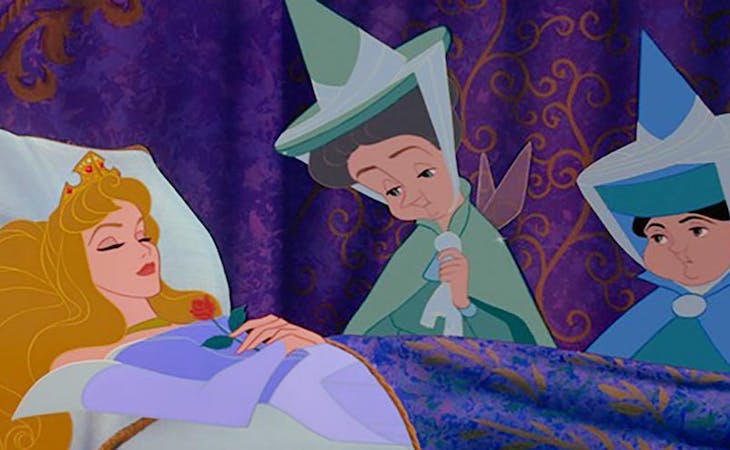From Sleeping Beauty to Inception, Hollywood has churned out dozens of movies about what happens after we close our eyes at night (or, in the case of Insomnia, don’t close our eyes). But how much of what movies depict about sleep is scientifically accurate, and how much is just cinematic license?
The same way filmmakers play with the laws of space and time in superhero and monster movies, they also stretch the realities of slumber. On the eve of this year’s Academy Awards, we consulted clinical sleep educator Terry Cralle, RN, to get her expert’s take on eight of our favorite silver screen sleeping stories.
Sleeping Beauty (1959)
Director: Clyde Geronimi
Stars: Mary Costa, Bill Shirley
The depiction: Disney’s animated classic might be the best-known version of this beloved fairy tale. The infant Princess Aurora (Costa) is placed under an enchantment by the witch Maleficent. On Aurora’s sixteenth birthday, the spell makes her fall asleep. Only a kiss from her true love, Prince Phillip (Shirley), can wake her. Needless to say, the prince finds Aurora in the tallest tower of the castle, where fairies have placed her on a comfortable bed, plants a kiss on her, and the two live happily ever after.
The reality: According to Cralle, there is some truth to the fairy tale. “There is a rare neurological disorder named Kleine-Levin Syndrome, or KLS, that is often referred to as ‘Sleeping Beauty Syndrome,'” she explains. In a twist from the movie, the disorder usually strikes male adolescents, Cralle says, and is characterized by periods of excessive sleep—as much as 20 hours per day. An episode can last days, weeks, or even months, during which the sufferer will appear confused, irritable, lethargic, and sensitive to light and noise.
A Nightmare on Elm Street (1984)
Director: Wes Craven
Stars: Robert Englund, John Saxon, Ronde Blakley, Heather Langenkamp, Johnny Depp
The depiction: This classic slasher film stars Englund as the iconic monster Freddie Krueger, a child murderer who was killed by angry parents after a judge released him on a legal technicality. Krueger returns after his death to haunt the dreams of the children of the parents who killed him. He dispatches his victims in their sleep in a variety of gruesome ways. Writer/director Wes Craven based the story on a number of articles he had read in the Los Angeles Times about refugees from war-torn countries who died in their sleep after a prolonged period of recurring nightmares.
The reality: While being murdered in your sleep by a bogeyman who invades your dreams is pure fantasy, we’ve all had intense, often memorable nightmares. “After a nightmare, the sleeper usually has very vivid and detailed dream recall,” Cralle says. Fear is the most commonly reported emotion in nightmares, which can be caused by factors including sleep deprivation, anxiety, stress, and depression, as well as disorders such as sleep apnea and restless legs syndrome.
The fact that Krueger haunts children’s dreams makes sense, given that nightmares are more common in children than adults. It is also not a stretch that the stories that inspired Craven to write the screenplay involved people who had fled war-torn countries. “Nightmares are a core component of PTSD,” Cralle says, noting that 90% of PTSD sufferers have reported disturbing dreams with some degree of resemblance to the original trauma.
Dreamscape (1984)
Director: Joseph Ruben
Stars: Dennis Quaid, Max von Sydow, Christopher Plummer, Kate Capshaw
The depiction: In this sci-fi film, Quaid plays Alex Gardner, a psychic who has the ability to link his mind with those of others during REM sleep and enter their dreams. Gardner learns of a government conspiracy that plans to use this technique as a method of assassination—and that the president of the United States is a target. Gardner, who previously used his psychic abilities for personal gain, feels compelled to stop the assassination.
The reality: Though Gardner’s ability to inhabit other people’s dreams is obviously fictional, the film is accurate about the importance of REM sleep to dreaming. “Most dreaming occurs during REM sleep,” Cralle notes. REM sleep, which accounts for around 20% of adult sleep time, is “marked by physiological changes that include irregular breathing, eye movement, and heart rate and blood pressure increased to near waking levels.” During periods of REM sleep, which tend to be longer as the night wears on, we are temporarily paralyzed to prevent acting out our dreams, except for movement of the eye muscles and diaphragm.
Fight Club (1999)
Director: David Fincher
Stars: Edward Norton, Brad Pitt, Helena Bonham Carter, Meat Loaf
The depiction: A cult classic, Fight Club centers on the narrator (Norton) and the extreme measures he takes to occupy his insomniac nights. He finally finds a way to fall asleep after engaging in new wee-hours activities, including an underground “fight club” with mysterious stranger Tyler Durden (Pitt). The twist in the film reveals that much more goes on in the narrator’s life than he realizes when he believes that he is sleeping.
The reality: Going for six months without sleep, as the narrator says he does, is well nigh impossible—the longest recorded time anyone has gone without sleep is approximately 11 days. But some degree of sleeplessness is widespread. “Of the more than 70 types of sleep disorders that exist, the most common sleep disorder is insomnia,” Cralle says.
A catchall term for insufficient sleep or poor sleep quality, insomnia can be either “transient,” meaning it lasts for a few days; “acute,” which persists for several weeks; or “chronic,” like the narrator’s, meaning it continues for months or even years. Most studies show that chronic insomnia affects between 9% and 17% of the population. According to the National Institutes of Health, many cases of chronic insomnia are side effects resulting from another primary problem.
Insomnia (2002)
Director: Christopher Nolan
Stars: Al Pacino, Robin Williams, Hilary Swank
The depiction: In this take on insomnia, a remake of a 1997 Norwegian thriller, Los Angeles Police Detective Will Dormer (Pacino) is sent to Alaska with another LAPD detective to investigate a murder. After accidentally shooting the other detective during the investigation and covering it up, Dormer is unable to sleep (the seasonal perpetual daylight in Alaska doesn’t help). Both Dormer’s sleeplessness and the circumstances surrounding the shooting make it difficult for him to proceed with the investigation.
The reality: In addition to underlying physical causes, insomnia can also be linked to personal, financial, and occupational stress. The relationship between sleep and stress is a vicious cycle: Stress can cause sleep disturbance, and sleep deprivation, in turn, can exacerbate stress.
As depicted in the film, insomnia can make it hard to function normally during waking hours. “Insomnia can lead to daytime impairments such as daytime sleepiness, mood disturbances, memory problems, decreased school and work performance, reduced psychomotor functioning, fatigue, decreased energy, error and accident proneness, decreased motivation, and decreased quality of life,” Cralle says. (Here are some tips for dealing with insomnia.)
The Science of Sleep (2006)
Director: Michel Gondry
Stars: Gael Garcia Bernal, Charlotte Gainsbourg
The depiction: In this quirky fantasy-comedy, Gael García Bernal portrays Stéphane Miroux, a man who has extremely creative dreams that often influence the way he interacts with others while he is awake. As the film progresses, it isn’t clear to either Miroux or the audience exactly which events take place in the real world and which ones are happening in Miroux’s surreal dreams.
The reality: Cralle quotes psychiatrist Myron Glucksman on the correlation between dreams and creativity. Glucksman observed that among his patients, “creative people, whether writers or artists, often are more in touch with their dreams. During conscious waking life, they are usually more aware of their inner life and their inner thoughts, and I think that transforms in terms of their sleeping life and their dream life.”
Step Brothers (2008)
Director: Adam McKay
Stars: Will Ferrell, John C. Reilly, Mary Steenburgen, Richard Jenkins, Adam Scott
The depiction: Brennan (Ferrell) and Dale (Reilly) play middle-aged slackers who, after Brennan’s mother marries Dale’s father, are forced to share a room. Although the two don’t get along at first, they later become friends and business partners. In a hilarious sequence, Dale and Brennan do absolutely ridiculous things while they sleepwalk, like dragging the family Christmas tree upstairs. However, as hilarious as it is, it only gets worse when they are woken up mid-sleepwalk.
The reality: While the sleepwalking scenes in Step Brothers might seem over the top, Cralle says, they are not out of the realm of possibility. “Sleepwalking can be a fairly benign condition,” she says. “A sleepwalking episode typically occurs about one or two hours after going to bed and can last anywhere from one to thirty minutes.” But sleepwalking in real life usually isn’t as funny as it is in the movie. “Accident reports from sleepwalking published in a 2013 study in Sleep included traumatic injuries with bruises, nose bleeding, fractures, abrasions, head contusions due to striking bedside tables, breaking walls, or jumping down stairs,” Cralle says. Some patients even exhibited “violent behaviors occurred toward bed partners who needed medical care after being attacked.”
In the movie, Robert (Jenkins) is advised not to wake his son and stepson during their sleepwalking episodes. This advice is accurate. “Safety is an important consideration for a sleepwalker,” Cralle continues. “If possible, help the sleepwalker return safely to bed without waking him or her. Sleepwalkers who wake up can be afraid, disoriented, and confused, so avoid startling or shaking a sleepwalker in close range as he or she may be confused, feel attacked, and lash out when awakened.”
Inception (2010)
Director: Christopher Nolan
Stars: Leonardo DiCaprio, Joseph Gordon-Levitt, Ken Watanabe, Marion Cotillard, Ellen Page, Tom Hardy, Cillian Murphy
The depiction: In Inception, Leonardo DiCaprio plays a thief, Dom Cobb, who specializes in stealing information from a person’s subconscious while they are dreaming by encountering them in a shared dream world. Cobb is hired by a businessman to implant an idea into the subconscious of a rival, which requires him and his team to infiltrate several increasingly dangerous “dream levels” of the rival’s psyche.
The reality: The concept of a shared dream world and the ability to manipulate it is pure science fiction. But the movie, and others like it, attests to our ongoing fascination with dreams and their meaning. “Dreams often involve replaying events that were part of our waking day,” Cralle says. “Dreams may be integral in finding solutions; providing different perspectives, insights, and even clarity into our thought processes and emotions.” (That’s one reason why dreaming can be good for your health.) Had an odd dream last night? It could be your brain processing unlikely solutions to problems on your mind. Or maybe it’s just something you ate.




